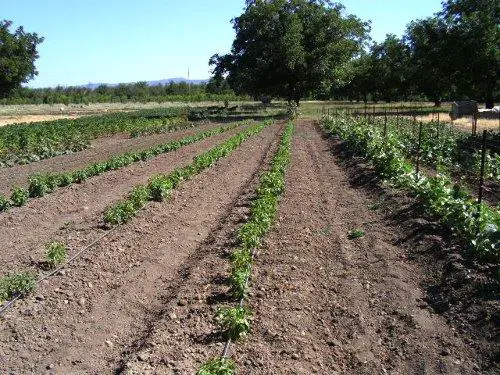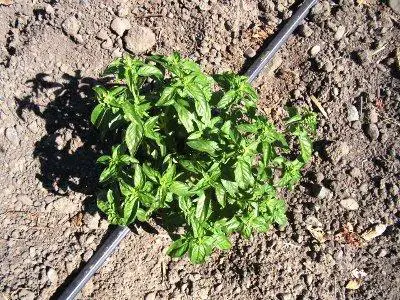
To paraphrase Elizabeth Barrett Browning, “Oh, basil, how do I love thee? Let me count the ways!”
This is the herb that makes the summer heat worthwhile. Contained within its shiny green leaves is one of the finest flavors on earth, and I found wonderful long rows of it during a recent visit to Leonardis Organics in Kelseyville.
The mere thought of this member of the mint family can make me salivate, and I'm a slave to its aroma.
When the heat strikes, I know it’s time for fresh tomato sandwiches flavored with basil leaves and for freshly-made pesto, another summertime treat, so you can imagine how pleased I was to see it at Jim Leonardis’ beautiful organic farm.
We are likely most familiar with the sweet basil that flavors Italian cuisine, or its close cousin, Genovese basil. These types are found in grocery stores and are most commonly grown by home gardeners. Another popular variety is Thai basil, which adds a pungent punch of flavor to Southeast Asian dishes.
But there is so much more.
Basil cross-pollinates easily, so determining a species can be challenging. It is estimated that there are between 50 and 150 varieties of the herb. Some are used in cuisine, and others in landscaping.
The size and shape of the leaves can vary dramatically, from the lettuce-like leaves of mammoth or lettuce basil (often used in salads) to the tiny leaves of dwarf bush basil.
Basil plants sport leaves ranging from bright green to deep purple, as evidenced by the colorful names of these varieties: Purple ruffles, African blue, red rubin and dark opal.
In addition to Thai basil, there’s Cuban basil, Greek basil, Mexican basil and Persian basil. It grows in columns (Greek column basil), in near perfect rounds (spicy globe basil), as a shrub or in dwarf bush form.
Some have flavors of cinnamon, licorice, lemon or lime.
The aptly named holy basil (sometimes known as Sacred basil) is used in Hindu worship, as well as to prepare holy water in the Greek Orthodox Church.
My personal favorite basil names are Magical Michael and Mrs. Burns lemon basil.
It is definitely a multi-faceted herb.
A native to the tropical regions of Asia, as well as to the warm climates of India and Iran, basil does well in the summer heat and has been cultivated in those countries for more than 5,000 years.
Its growing season and conditions mirror those of the tomato, and they are often matched in cuisine. Personally, I can’t think of two flavors that trump the marriage of a ripe-from-the-vine tomato and pungent, powerful, spicy basil.
The word “basil” is derived from the Greek word basileus, which means king or royal. Some call it “The King of Herbs,” and it’s uncertain whether this moniker is from the word origin or its powerful place in cuisine.
It carries quite a bit of weight in sometimes conflicting folklore around the world.
While it’s a symbol of love in Italy and Portugal, it represented hatred in ancient Greece.
European lore sometimes claimed that basil is a symbol of Satan, but it is said to have been found around the tomb of Christ after the resurrection.
In Africa, legend claims that basil protects against scorpions; however, a French physician (as quoted by an English botanist) claimed that it is common knowledge that smelling basil breeds scorpions in the brain.

Again, it’s definitely a multi-faceted herb.
Basil is extremely high in vitamin K, with a full 60 percent of our daily requirement being found in just over a tablespoon of the fresh herb. It’s a good source of beta carotene, vitamins A and C, calcium and dietary fiber, as well as the minerals manganese, magnesium and potassium.
Scientific studies have established that the essential oils found in basil have potent antioxidant, anti-cancer, antiviral and anti-microbial properties.
While most dried herbs provide a concentrated dose of flavor similar to their fresh counterparts, dried basil is quite a different animal. It just doesn’t have the same flavor, and for this reason, I don’t keep it in my home pantry, nor do I use it in cooking.
The flavor compounds in fresh basil are volatile, so if cooked for longer than the briefest period, its characteristic pungency is lost. Fresh basil should be added at the last possible minute when using it to flavor hot dishes.
Fresh herbs such as basil may be stored in the fridge in a couple of ways. If there’s room on your refrigerator shelves, cut the bottoms of the stems as you would fresh flowers and place in a glass of water. Otherwise, wrap in damp paper towels and seal in a zipper locked bag. Both methods will keep basil fresh for days.
When basil comes in fast and furious at local farmers’ markets, take home several bunches to puree and freeze that which you can’t use immediately.
Use a food processor or blender for this purpose, adding just enough water or olive oil to make a loose paste. Freeze in ice cube trays, and when frozen, pop the bright green cubes out to store in freezer safe zipper locked bags. They’re wonderful for making fresh pesto in the winter months or for flavoring soups or sauces.
The recipe below is from a culinary class I taught that featured local goat cheese. It offers another way to use pesto, and the flavor of basil is fresh and bright with sweet sun dried tomatoes and tangy goat cheese. It makes an impressive hors d’oeuvre with layers of red, green and white.
Pine nuts have become quite expensive – the price in our local store went from about $17 per pound to $35 – so when making pesto for other uses, walnuts make a fine substitute for pine nuts. (For an extra layer of flavor, toast the walnuts first.) Since this torte is garnished with toasted pine nuts, I’d recommend using pine nuts in the pesto. Thankfully, 1/3 cup doesn’t weigh much!
Layered pesto, goat cheese and tomato torte with pine nuts
10-12 ounce fresh goat cheese
1 cup packed basil leaves
¼ cup extra virgin olive oil
1 clove garlic
1/3 cup pine nuts (toast half of them)
½ tsp salt
½ cup roughly chopped sun dried tomatoes, along with their oil to drizzle (or fresh halved cherry tomatoes when in season)
Balsamic vinegar to drizzle
Line a 5- or 6-inch springform pan or a shallow bowl (such as for soup) with plastic wrap, leaving enough extra wrap on either side for covering up afterwards. Press half the goat cheese into the bottom using the back of a spoon.
Combine the basil, olive oil, garlic, half the pine nuts and salt in a food processor and pulse to combine. Spoon this thick pesto mixture over the goat cheese. Top with the rest of the cheese and press gently with the back of a spoon to smooth into place. Wrap tightly and chill for at least one hour and up to 24 hours.
When ready to serve, unmold and top the torte with the tomatoes and drizzle with their oil (or extra virgin olive oil if using fresh tomatoes) and a bit of balsamic vinegar. Garnish with the remaining pine nuts (toasted if desired) and serve with croCroûtons:ûtons made from baguette slices. (See recipe below.)
Makes 6 servings.
Croûtons
Brush 12 pieces of thinly sliced French bread baguette with olive oil and toast in a 450-degree oven until golden brown. Rub with a garlic clove after cooking.
Esther Oertel, the "Veggie Girl," is a personal chef and culinary coach and is passionate about local produce. Oertel owns The SageCoach Personal Chef Service and teaches culinary classes at Chic Le Chef in Hidden Valley Lake. She welcomes your questions and comments; e-mail her at This email address is being protected from spambots. You need JavaScript enabled to view it..
Follow Lake County News on Twitter at http://twitter.com/LakeCoNews and on Facebook at http://www.facebook.com/pages/Lake-County-News/143156775604?ref=mf .